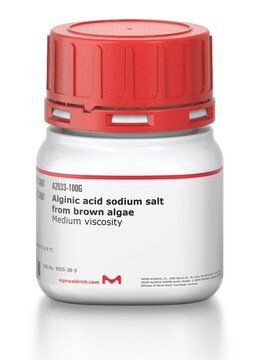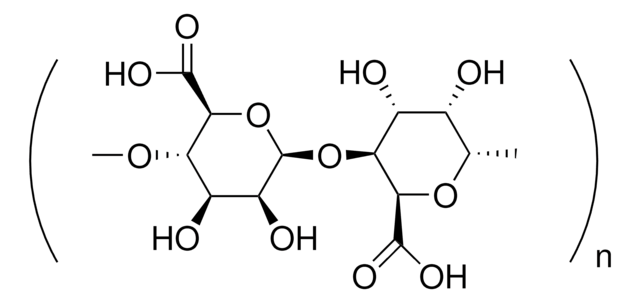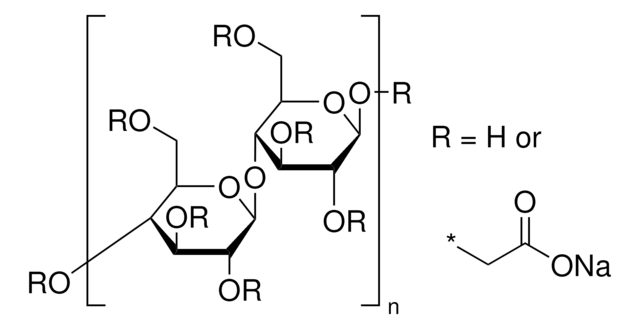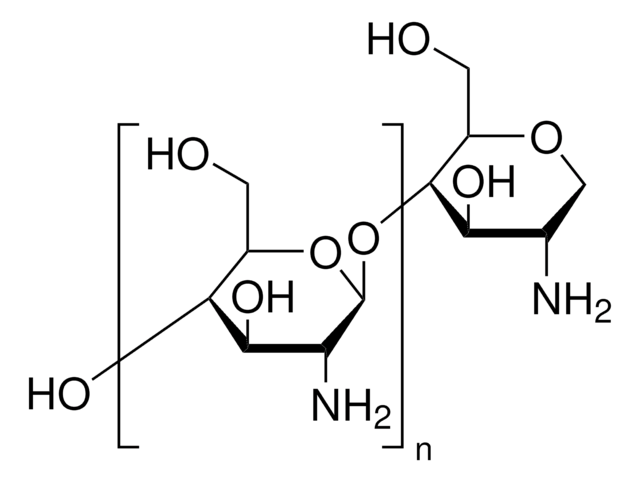180947
Alginic acid sodium salt
powder
Sinónimos:
Algin, Sodium alginate
About This Item
Productos recomendados
origen biológico
algae (marine)
Nivel de calidad
Formulario
powder
viscosidad
15-25 cP, 1 % in H2O
cadena SMILES
[Na+].[O-]C(=O)C1O[C@H]([C@H]([C@H]([C@@H]1O)O)O)O
InChI
1S/C6H10O7.Na/c7-1-2(8)4(5(10)11)13-6(12)3(1)9;/h1-4,6-9,12H,(H,10,11);/q;+1/p-1/t1-,2-,3-,4?,6+;/m0./s1
Clave InChI
MSXHSNHNTORCAW-MPGIDXPLSA-M
¿Está buscando productos similares? Visita Guía de comparación de productos
Categorías relacionadas
Descripción general
Aplicación
- in combination with chitosan, to fabricate a biodegradable porous scaffold for bone tissue engineering.
- to study the characteristics of a modified amphiphilic alginate derivative
- to the study the impact of alginate on the rate of lipid digestion by employing an in vitro digestion model
- in the preparation of alginate hydrogels
- as encapsulating agents of microparticles of β-galactosidae
Código de clase de almacenamiento
11 - Combustible Solids
Clase de riesgo para el agua (WGK)
WGK 1
Punto de inflamabilidad (°F)
Not applicable
Punto de inflamabilidad (°C)
Not applicable
Equipo de protección personal
Eyeshields, Gloves, type N95 (US)
Elija entre una de las versiones más recientes:
Certificados de análisis (COA)
¿No ve la versión correcta?
Si necesita una versión concreta, puede buscar un certificado específico por el número de lote.
¿Ya tiene este producto?
Encuentre la documentación para los productos que ha comprado recientemente en la Biblioteca de documentos.
Artículos
Chitosan Biopolymer from Fungal Fermentation for Delivery of Chemotherapeutic Agents
Collagen molecules play a critical role in tissue architecture and strength, and in cell-matrix interactions as insoluble ligands to regulate the diverse phenotypic activities of cells.
The use of hydrogel-based biomaterials for the delivery and recruitment of cells to promote tissue regeneration in the body is of growing interest. This article discussed the application of hydrogels in cell delivery and tissue regeneration.
Global Trade Item Number
| Número de referencia del producto (SKU) | GTIN |
|---|---|
| 180947-500G | 4061838755056 |
| 180947-5G | |
| 180947-100G | 4061835561537 |
| 180947-1KG | |
| 180947-250G | 4061835561544 |
Nuestro equipo de científicos tiene experiencia en todas las áreas de investigación: Ciencias de la vida, Ciencia de los materiales, Síntesis química, Cromatografía, Analítica y muchas otras.
Póngase en contacto con el Servicio técnico







